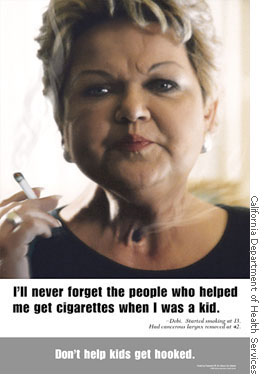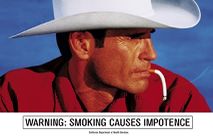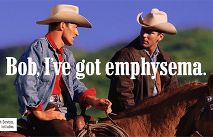Turn-off Tactics
![]() Receive new posting via RSS feed. >Click the icon on the left to subscribe.
Receive new posting via RSS feed. >Click the icon on the left to subscribe.
(Or right click the icon to copy and paste the link into your rss reader)
Can advertising turn people off, as effectively as it can turn people on?
Anti-smoking and road safety, public service advertising has been very effective over the years though the success of using fear appeals amongst the young has been spotty. Adolescents often regard themselves as almost immortal and their bodies as virtually 'bullet proof'. Below are some of the advertising appeals that have been aimed at various target groups from various countries.
Note that a number of my columns have focused on turn-off tactics and can be found at the following links:
Temptation Turn-off Tactics: Lead Me Not Into Temptation
Conformity as a Turn-off Tactic: Reducing Energy Consumption
Turn-off Tactics: More New Insights
Why Willpower Wanes: The Tussle of the Muscle
16th November, 2007
Turn-off Tactic 1(b): Associate the activity with ridicule.
This is a variation on Turn-off Tactic 1 (i.e. Associating the activity or product with something scary). Ridicule, like things that are scary, can have powerful emotional effects. In this commercial for the Road Traffic Authority (NSW) in Australia, the anti-speeding message "Speeding. No-one Thinks Big of You" seems lame if articulated in words . But look what happens when a gesture of ridicule is recruited and associated with the behavior. (You need to know that in Australia, the gesture of extending and then contracting the little finger is a ridicule gesture that means 'small penis'.)
1 April, 2007
Negative Imagery - Effective or Ineffective?
Some people object to fear appeals and negative imagery - especially smokers themselves - but are they effective? Here's an articulate smoker who objects strongly to the these turn-off tactics - especially the on-pack graphics. He argues the negative images are counterproductive for confirmed smokers (what about preventing kids from starting?) and advocates positive instead of negative appeals. (One example...replacement of on-pack images with hints for successful quitting like "It is easier to quit when a friend quits smoking with you."). All this is pitched in a spirit of smoker rebellion against government actions that 'demonize' smokers. The video is VERY long, so as soon as you get a feel for what he is on about, you might want to skip to the final 20% where he gives examples of what he sees as 'positive appeals'.
And here's a cute follow-up, cartooning the argument in terms of love (or positive appeals) being more persuasive than hate (or negative appeals).
16th December, 2006
Turn-off tactic 7: Increase the Salience of Known Consequences by Dramatization or Virtual Reality.
The following ad by DDB Canada is about as graphic as you can get in dramatizing the consequences of drink driving. It is about as close as you can get to experiential learning without actually having to be there and have the experience happen to you.
It is not until you visit an abattoirs and see the killing process that the knowledge that beef is dead animal, becomes experiential. Knowing something experientially has greater salience because it usually comes with longer-lasting, vividly graphic imagery. It is one thing to know something - and another to feel it. A lot has to do with how fluent the images are i.e. how readily they spring to mind.
Not wearing a seatbelt is dangerous and everybody knows that also. Here's an ad that dramatizes and reinforces that knowledge (turn-off tactic 7), but at the same time also communicates new information. The new information is that your body becomes a projectile within the vehicle that causes injury to other passengers. This ad also uses a very different style of dramatization (and musical lyrics).
15th November 2006
Turn-off tactic 1: Associate the product with something that is scary - Death.
Ads using this turn off tactic usually benefit from the shock-and-awe approach. But can you have too much it? You be the judge. This Philipino TV ad is shockingly awful.
Here's the same message executed with 'somewhat less' shock and awe. But still very confronting.
11th November 2006
Quit (Smoking) Campaign: More Turn-off Tactic 1 - Associate It With Something Scary.
This time, the something scary is mouth cancer.
This ad was very controversial not just because it is confronting but also because the woman is an actress fitted with a prosthetic mouth. Is it dishonest to 'fake' the depiction of the scary turn-off stuff? (more here).
1st November 2006
Analogies To Stiffen Resistance: Turn-off Tactic 6
Originally posted at Adrants this American Legacy ad uses lustful imagery of the typical male fantasy and aligns the alluring temptation of smoking with that of a hot female. It certainly gets attention for a website . Does it qualify for a turn-off tactic? I guess so.
26 May 2006
Galvanising Manipulative Resistance: Turn-off Tactic 5.
Young people hate being manipulated by grown-ups so one turn off tactic is to trigger their active resistance by showing how the cigarette companies (the grown ups) go about their influence through advertising and promotion. This approach taken by the Arnold ad agency simply lays the facts out for teens to consider for themselves. Check out this turn-off tactic in their 'Truth ads' here. Thanks to Chris Middleton (Arnold Boston) for pointing them out.
Also check out the famous 'body bags' ad here. An ad tapping into what motivates teenagers, "it has a slight anarchistic vibe, with a message that goes up against big corporations, all packaged in a fast-paced, gritty and edgy film clip and designed to catch the eye of rebellious teens.” [see Nicholson, C. (2007). "Framing Science." Observer 20(1) for more on it]
13 May 2006
Turn-off tactic 1: Associate the product with something that is scary.
Throat Cancer

Impotence
Lung Cancer
.jpg)
Gangrene
Death
.jpg)
Turn-off tactic 2: Appeal to love of family.
.jpg)

.jpg)
Turn-off Tactic 3: Parody slipstream well known cigarette ads


Turn-off Tactic 4: Social Stigma
.jpg)
.jpg)
NHS TV ad "If you smoke, you stink"
On-pack warnings from various countries can be found in the World Tobacco-Control Image Database.



